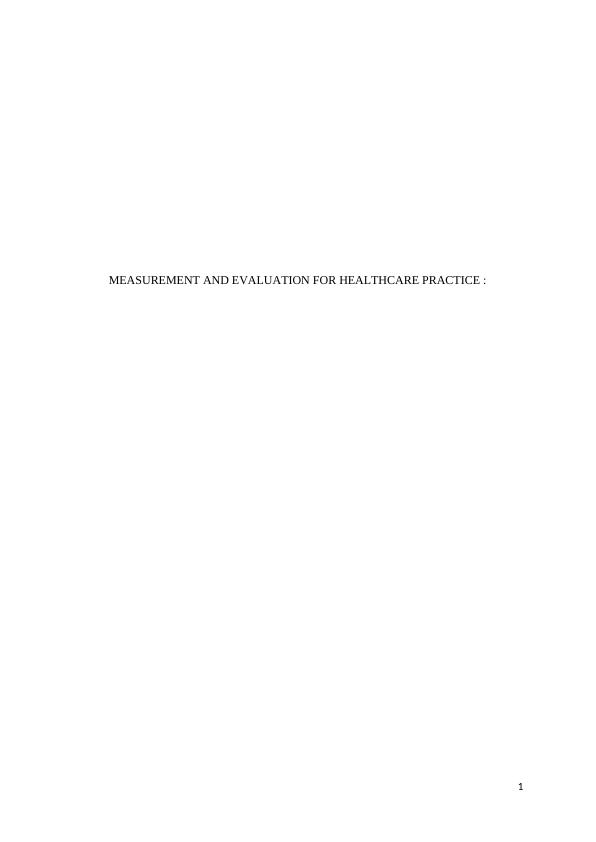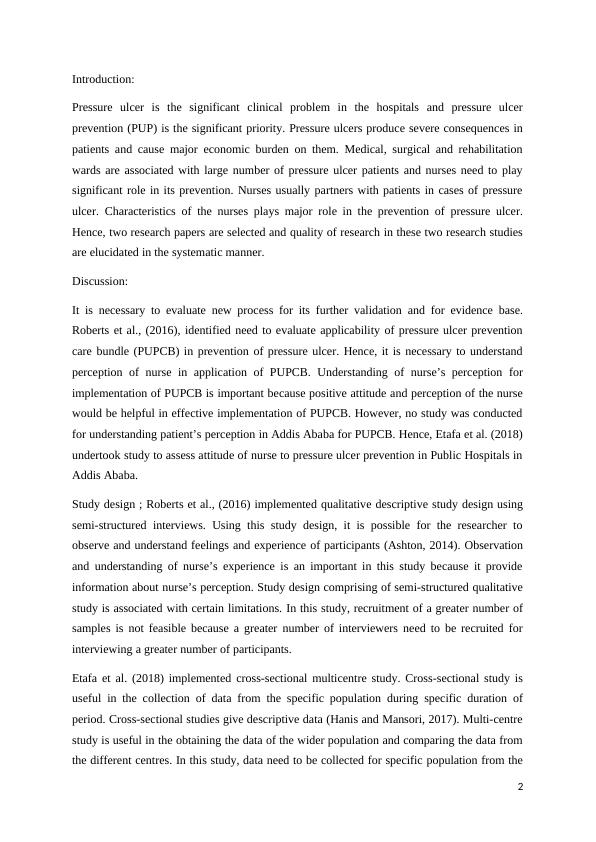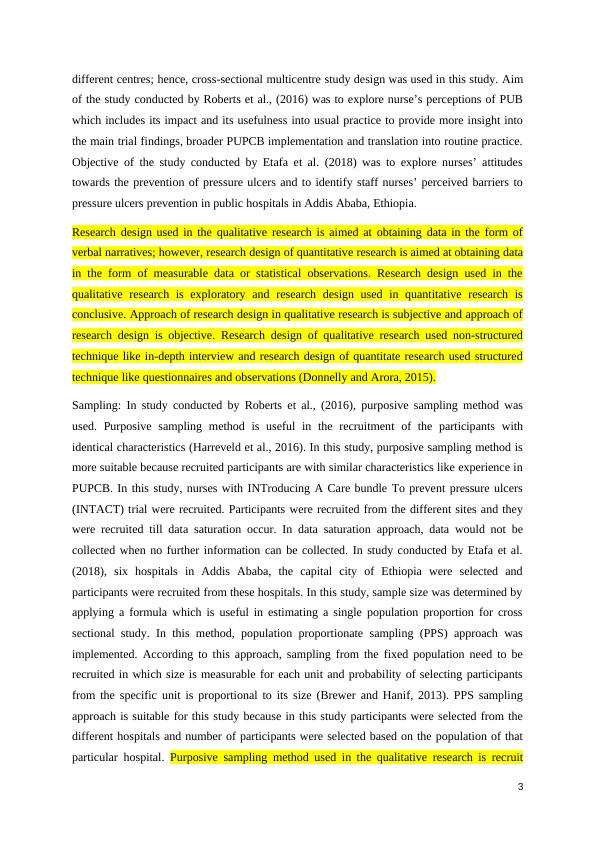Measurement and evaluation for healthcare practice PDF
8 Pages2924 Words37 Views
Added on 2021-12-22
Measurement and evaluation for healthcare practice PDF
Added on 2021-12-22
ShareRelated Documents
MEASUREMENT AND EVALUATION FOR HEALTHCARE PRACTICE :
1
1

Introduction:
Pressure ulcer is the significant clinical problem in the hospitals and pressure ulcer
prevention (PUP) is the significant priority. Pressure ulcers produce severe consequences in
patients and cause major economic burden on them. Medical, surgical and rehabilitation
wards are associated with large number of pressure ulcer patients and nurses need to play
significant role in its prevention. Nurses usually partners with patients in cases of pressure
ulcer. Characteristics of the nurses plays major role in the prevention of pressure ulcer.
Hence, two research papers are selected and quality of research in these two research studies
are elucidated in the systematic manner.
Discussion:
It is necessary to evaluate new process for its further validation and for evidence base.
Roberts et al., (2016), identified need to evaluate applicability of pressure ulcer prevention
care bundle (PUPCB) in prevention of pressure ulcer. Hence, it is necessary to understand
perception of nurse in application of PUPCB. Understanding of nurse’s perception for
implementation of PUPCB is important because positive attitude and perception of the nurse
would be helpful in effective implementation of PUPCB. However, no study was conducted
for understanding patient’s perception in Addis Ababa for PUPCB. Hence, Etafa et al. (2018)
undertook study to assess attitude of nurse to pressure ulcer prevention in Public Hospitals in
Addis Ababa.
Study design ; Roberts et al., (2016) implemented qualitative descriptive study design using
semi-structured interviews. Using this study design, it is possible for the researcher to
observe and understand feelings and experience of participants (Ashton, 2014). Observation
and understanding of nurse’s experience is an important in this study because it provide
information about nurse’s perception. Study design comprising of semi-structured qualitative
study is associated with certain limitations. In this study, recruitment of a greater number of
samples is not feasible because a greater number of interviewers need to be recruited for
interviewing a greater number of participants.
Etafa et al. (2018) implemented cross-sectional multicentre study. Cross-sectional study is
useful in the collection of data from the specific population during specific duration of
period. Cross-sectional studies give descriptive data (Hanis and Mansori, 2017). Multi-centre
study is useful in the obtaining the data of the wider population and comparing the data from
the different centres. In this study, data need to be collected for specific population from the
2
Pressure ulcer is the significant clinical problem in the hospitals and pressure ulcer
prevention (PUP) is the significant priority. Pressure ulcers produce severe consequences in
patients and cause major economic burden on them. Medical, surgical and rehabilitation
wards are associated with large number of pressure ulcer patients and nurses need to play
significant role in its prevention. Nurses usually partners with patients in cases of pressure
ulcer. Characteristics of the nurses plays major role in the prevention of pressure ulcer.
Hence, two research papers are selected and quality of research in these two research studies
are elucidated in the systematic manner.
Discussion:
It is necessary to evaluate new process for its further validation and for evidence base.
Roberts et al., (2016), identified need to evaluate applicability of pressure ulcer prevention
care bundle (PUPCB) in prevention of pressure ulcer. Hence, it is necessary to understand
perception of nurse in application of PUPCB. Understanding of nurse’s perception for
implementation of PUPCB is important because positive attitude and perception of the nurse
would be helpful in effective implementation of PUPCB. However, no study was conducted
for understanding patient’s perception in Addis Ababa for PUPCB. Hence, Etafa et al. (2018)
undertook study to assess attitude of nurse to pressure ulcer prevention in Public Hospitals in
Addis Ababa.
Study design ; Roberts et al., (2016) implemented qualitative descriptive study design using
semi-structured interviews. Using this study design, it is possible for the researcher to
observe and understand feelings and experience of participants (Ashton, 2014). Observation
and understanding of nurse’s experience is an important in this study because it provide
information about nurse’s perception. Study design comprising of semi-structured qualitative
study is associated with certain limitations. In this study, recruitment of a greater number of
samples is not feasible because a greater number of interviewers need to be recruited for
interviewing a greater number of participants.
Etafa et al. (2018) implemented cross-sectional multicentre study. Cross-sectional study is
useful in the collection of data from the specific population during specific duration of
period. Cross-sectional studies give descriptive data (Hanis and Mansori, 2017). Multi-centre
study is useful in the obtaining the data of the wider population and comparing the data from
the different centres. In this study, data need to be collected for specific population from the
2

different centres; hence, cross-sectional multicentre study design was used in this study. Aim
of the study conducted by Roberts et al., (2016) was to explore nurse’s perceptions of PUB
which includes its impact and its usefulness into usual practice to provide more insight into
the main trial findings, broader PUPCB implementation and translation into routine practice.
Objective of the study conducted by Etafa et al. (2018) was to explore nurses’ attitudes
towards the prevention of pressure ulcers and to identify staff nurses’ perceived barriers to
pressure ulcers prevention in public hospitals in Addis Ababa, Ethiopia.
Research design used in the qualitative research is aimed at obtaining data in the form of
verbal narratives; however, research design of quantitative research is aimed at obtaining data
in the form of measurable data or statistical observations. Research design used in the
qualitative research is exploratory and research design used in quantitative research is
conclusive. Approach of research design in qualitative research is subjective and approach of
research design is objective. Research design of qualitative research used non-structured
technique like in-depth interview and research design of quantitate research used structured
technique like questionnaires and observations (Donnelly and Arora, 2015).
Sampling: In study conducted by Roberts et al., (2016), purposive sampling method was
used. Purposive sampling method is useful in the recruitment of the participants with
identical characteristics (Harreveld et al., 2016). In this study, purposive sampling method is
more suitable because recruited participants are with similar characteristics like experience in
PUPCB. In this study, nurses with INTroducing A Care bundle To prevent pressure ulcers
(INTACT) trial were recruited. Participants were recruited from the different sites and they
were recruited till data saturation occur. In data saturation approach, data would not be
collected when no further information can be collected. In study conducted by Etafa et al.
(2018), six hospitals in Addis Ababa, the capital city of Ethiopia were selected and
participants were recruited from these hospitals. In this study, sample size was determined by
applying a formula which is useful in estimating a single population proportion for cross
sectional study. In this method, population proportionate sampling (PPS) approach was
implemented. According to this approach, sampling from the fixed population need to be
recruited in which size is measurable for each unit and probability of selecting participants
from the specific unit is proportional to its size (Brewer and Hanif, 2013). PPS sampling
approach is suitable for this study because in this study participants were selected from the
different hospitals and number of participants were selected based on the population of that
particular hospital. Purposive sampling method used in the qualitative research is recruit
3
of the study conducted by Roberts et al., (2016) was to explore nurse’s perceptions of PUB
which includes its impact and its usefulness into usual practice to provide more insight into
the main trial findings, broader PUPCB implementation and translation into routine practice.
Objective of the study conducted by Etafa et al. (2018) was to explore nurses’ attitudes
towards the prevention of pressure ulcers and to identify staff nurses’ perceived barriers to
pressure ulcers prevention in public hospitals in Addis Ababa, Ethiopia.
Research design used in the qualitative research is aimed at obtaining data in the form of
verbal narratives; however, research design of quantitative research is aimed at obtaining data
in the form of measurable data or statistical observations. Research design used in the
qualitative research is exploratory and research design used in quantitative research is
conclusive. Approach of research design in qualitative research is subjective and approach of
research design is objective. Research design of qualitative research used non-structured
technique like in-depth interview and research design of quantitate research used structured
technique like questionnaires and observations (Donnelly and Arora, 2015).
Sampling: In study conducted by Roberts et al., (2016), purposive sampling method was
used. Purposive sampling method is useful in the recruitment of the participants with
identical characteristics (Harreveld et al., 2016). In this study, purposive sampling method is
more suitable because recruited participants are with similar characteristics like experience in
PUPCB. In this study, nurses with INTroducing A Care bundle To prevent pressure ulcers
(INTACT) trial were recruited. Participants were recruited from the different sites and they
were recruited till data saturation occur. In data saturation approach, data would not be
collected when no further information can be collected. In study conducted by Etafa et al.
(2018), six hospitals in Addis Ababa, the capital city of Ethiopia were selected and
participants were recruited from these hospitals. In this study, sample size was determined by
applying a formula which is useful in estimating a single population proportion for cross
sectional study. In this method, population proportionate sampling (PPS) approach was
implemented. According to this approach, sampling from the fixed population need to be
recruited in which size is measurable for each unit and probability of selecting participants
from the specific unit is proportional to its size (Brewer and Hanif, 2013). PPS sampling
approach is suitable for this study because in this study participants were selected from the
different hospitals and number of participants were selected based on the population of that
particular hospital. Purposive sampling method used in the qualitative research is recruit
3

End of preview
Want to access all the pages? Upload your documents or become a member.
Related Documents
Prevention of Pressure Ulcers: Attitudes and Perceived Hindrances of Nurses - A Critique of Two Studieslg...
|10
|2917
|395
The Effectiveness of a Pressure Ulcer Intervention Programlg...
|6
|1997
|12
Wound Management: A Nutritional Formula for Healing Pressure Ulcerslg...
|14
|2076
|56
Quality Improvement Project - Nursing Education Traininglg...
|5
|1079
|22
Prevalence and Management of Pressure Ulcers in Acute Care Wards: A Systematic Reviewlg...
|78
|24275
|382
Critical Appraisal of a Research Article on Caregiver's Experience in Rehabilitation of Stroke Patientslg...
|6
|1832
|157
